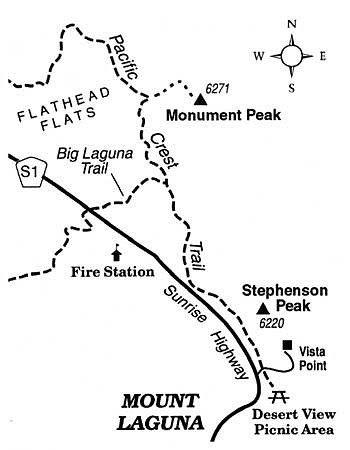 Facebook
Facebook
 X
X
 Instagram
Instagram
 TikTok
TikTok
 Youtube
Youtube
San Diego County is riddled with edges or "ecotones" -- boundaries between different geographic regions or ecological habitats. Ecotones harbor great biological diversity and often feature spectacular scenery, especially when the transition from one type of landscape to another is abrupt. Ecotones abound at the ocean's edge, where coastal sage scrub changes into coastal strand or rocky shore habitat and that in turn grades into the intertidal zone. Another major ecotone snakes its way along the county's peaked roof -- the top of the Peninsular Ranges some 40 to 50 miles inland. In places, a strip of land just a few hundred feet wide separates cool plateau forests from steeply plunging slopes falling straightway to the desert floor.
A 40-minute stroll through pine woods and windblown chaparral in the Laguna Mountains suffices to take you to Monument Peak, smack-dab on the mountain-desert ecotone. A small cluster of communication antennas rests on Monument Peak, a testament to the mountain's strategic geographic position. Few hikers come this way; as a result, the shortest route to the summit is obscure and requires a bit of navigational attention.
From San Diego drive east on Interstate 8 to Sunrise Highway, and follow Sunrise Highway north about ten miles to mile 25.2 (according to the small green highway mile markers posted every half mile). Park off the pavement on the right (east) side of the road, and start walking uphill on the signed Big Laguna Trail. Initially, you traverse an area dotted with Jeffrey pines and black oaks that was spared in both the 2002 Pines Fire and the 2003 Cedar Fire conflagrations. Proceed 0.5 mile uphill to a junction with the Pacific Crest Trail. Turn left, and continue moderately uphill, counting your paces as you go. After about 800 steps, you get a glimpse of microwave antennas ahead. This is an important clue. At the next sharp leftward bend in the trail, keep going straight on an informal path up the rocky slope. Soon, the path bends to the right and you clamber up to and around a fenced laser-research facility to join a paved access road that is closed to public automobile traffic.
Follow that road to Monument Peak's summit, where the vista of earth and sky spreads incredibly far and wide, particularly around the beginning and the end of each clear day. Early in the day, the sun vaults above a bluish horizon shaped by Arizona peaks. Late in the afternoon, Laguna Mountain shadows lengthen across the floor of the Anza-Borrego Desert, racing ever faster over sandy flats and badlands a mile in elevation below.


San Diego County is riddled with edges or "ecotones" -- boundaries between different geographic regions or ecological habitats. Ecotones harbor great biological diversity and often feature spectacular scenery, especially when the transition from one type of landscape to another is abrupt. Ecotones abound at the ocean's edge, where coastal sage scrub changes into coastal strand or rocky shore habitat and that in turn grades into the intertidal zone. Another major ecotone snakes its way along the county's peaked roof -- the top of the Peninsular Ranges some 40 to 50 miles inland. In places, a strip of land just a few hundred feet wide separates cool plateau forests from steeply plunging slopes falling straightway to the desert floor.
A 40-minute stroll through pine woods and windblown chaparral in the Laguna Mountains suffices to take you to Monument Peak, smack-dab on the mountain-desert ecotone. A small cluster of communication antennas rests on Monument Peak, a testament to the mountain's strategic geographic position. Few hikers come this way; as a result, the shortest route to the summit is obscure and requires a bit of navigational attention.
From San Diego drive east on Interstate 8 to Sunrise Highway, and follow Sunrise Highway north about ten miles to mile 25.2 (according to the small green highway mile markers posted every half mile). Park off the pavement on the right (east) side of the road, and start walking uphill on the signed Big Laguna Trail. Initially, you traverse an area dotted with Jeffrey pines and black oaks that was spared in both the 2002 Pines Fire and the 2003 Cedar Fire conflagrations. Proceed 0.5 mile uphill to a junction with the Pacific Crest Trail. Turn left, and continue moderately uphill, counting your paces as you go. After about 800 steps, you get a glimpse of microwave antennas ahead. This is an important clue. At the next sharp leftward bend in the trail, keep going straight on an informal path up the rocky slope. Soon, the path bends to the right and you clamber up to and around a fenced laser-research facility to join a paved access road that is closed to public automobile traffic.
Follow that road to Monument Peak's summit, where the vista of earth and sky spreads incredibly far and wide, particularly around the beginning and the end of each clear day. Early in the day, the sun vaults above a bluish horizon shaped by Arizona peaks. Late in the afternoon, Laguna Mountain shadows lengthen across the floor of the Anza-Borrego Desert, racing ever faster over sandy flats and badlands a mile in elevation below.
